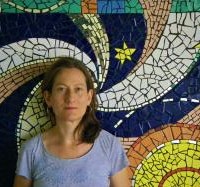With only two weeks to go before the American presidential election, the question of what—if anything—yoga and mindfulness might contribute to politics looms larger than ever.
Michael Stone’s essay in the newly released book, 21st Century Yoga: Culture, Politics, and Practice, along with his recent discussion of it on Where is My Guru, provide a fantastic set of resources with which to explore this issue. Unlike most commentary on yoga and politics, Michael manages to steer skillfully between the Scylla of sweet spiritual platitudes that obfuscate political reality, and the Charybdis of zealous political ideologies that mow down spirituality the name of expediency.
In other words, he manages to write in a way that’s both politically substantive and spiritually meaningful—no easy task in today’s ideologically-riven climate.
Occupy Your Imagination
Michael’s essay, “Our True Nature is Our Imagination: Yoga and Non-Violence at the Edge of the World,” shares his reflections on visiting New York’s Zuccotti Park during the peak of the Occupy Wall Street movement—which, astonishing as it may seem, was only a little over a year ago today:
“I’m here at Zuccotti Park, but not with the cliché arsenal of a yoga mat or meditation cushion. Instead, I’m trying to learn how the activist community, the spiritual community, and the economists can build bridges. Instead of attending the public yoga class, I’ve been learning about General Assemblies, the human microphone, hand signals and what kind of research is needed to generate sweeping changes that bring attention and help to the unwanted parts of our society, as well as to our overall ecology. It feels like I’m trying to build a bridge at the end of the world.”
The essay goes on to discuss how yoga and meditation can be important in this process of bridge-building:
“We are awakening from a dream. Modern yoga is also a collective awakening and it will be interesting to see if we can transition from a personal practice into a collective voice for social change. We all suffer from the increasing paradox of living in a time whose old ways and values are dying (and taking waterways, species, languages, and air quality with it) while the new one seems unable to be born. Stopping in our tracks, like we do in meditation practice, begins the slow unraveling of our momentum so we can see what is here to emerge.
. . . Over and over, Patanjali teaches that what causes suffering is holding on to inflexible views. The stories that govern our lives are also the narratives that keep us locked into set patterns, habits, and addictions. The same psychological tools that yogis have mapped for helping us let go of one-track rigid stories can be applied not just personally, but socially.”
Michael’s work shows us how yoga and mindfulness can help us engage with the economic, environmental, political and social crises of our time without being overcome with the negative emotions of fear, anger, cynicism and fanaticism they so easily generate. The combination of grounding ourselves through practice while also pursuing political learning and engagement opens new possibilities. Rather than retreating into worn-out ideologies, we trust our innate capacities for creativity, connection and regeneration.
Read Michael’s essay in 21st Century Yoga (available via its website or Amazon) and listen to his recent interview with Roseanne Harvey that reconsiders his take on Occupy now that the movement has been forced off the streets and faded from the headlines.
Michael Stone is a yoga teacher, Buddhist teacher, author, and psychotherapist. He is the Founder of Centre of Gravity, a community in downtown Toronto integrating everyday formal practice and social action. He is a voice for a new generation of young people synthesizing spiritual practice with environmental and social issues. His most recent book is Awake in the World: Teachings from Yoga & Buddhism for Living an Engaged Life (Shambhala 2011). You can find him online at www.centreofgravity.org.
Featured photo via Toronto Body Mind.
~
Editor: Kate Bartolotta











Read 2 comments and reply